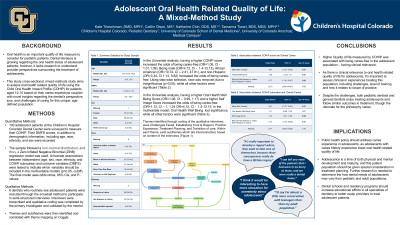Caries
133 - Adolescent Oral Health Related Quality of Life: A Mixed-Method Study

.jpeg.jpg)
Kate E. Trieschman, DMD, MPH (she/her/hers)
Resident
Children's Hospital Colorado, Aurora, CO
Children's Hospital Colorado
Denver, Colorado, United States- KC
Katherine Chin, DDS, MS
Children's Hospital Colorado
- KO
Kaitlin Olson, MS
University of Colorado Anschutz Medical Campus
- TT
Tamanna Tiwari, BDS, MDS, MPH
University of Colorado Anschutz Medical Campus

Chaitanya P. Puranik, BDS, MS, M.Dent.Sci, Ph.D.
Program Director
Children’s hospital Colorado
Children's Hospital Colorado and School of Dental Medicine, University of Colorado Anschutz Medical Campus
Aurora, Colorado, United States
Presenting Author(s)
Co-Author(s)
Program Director(s)
Purpose: Oral health is an important quality of life measure to consider for pediatric patients. This study assesses oral health related quality of life (OHRQoL) for patients aged 12-15 based on their Decayed, Missing, Filled Surfaces (DMFS) scores coupled with novel insights regarding the dentist’s perspective caring for this population.
Methods: In this mixed-methods study, 100 adolescent patients at the Children’s Hospital Colorado Dental Center were surveyed to measure their Child Oral Health Impact Profile (COHIP) and their DMFS scores were measured. Relationships between variables and the COHIP were assessed univariately. Additionally, 6 dentists who routinely see adolescent patients were recruited through the snowball method to participate in semi-structured interviews. Interviews were transcribed and qualitative coding was completed by the primary investigator and validated by the mentor.
Results: Comparable COHIP scores were found across ethnicity, race, gender, and age. Mean COHIP scores were significantly associated with DMFS among adolescent patients (P=.002). Dentists report their role as a guiding figure for adolescents, as well as a figure of accountability. They report challenges regarding scope of practice and insufficient training in treating adolescent patients.
Conclusion: Given the significant decrease in quality of life for adolescents with a greater caries experience, and the challenges reported by dentists, there is a gap in dentistry meeting the needs of adolescent patients. Further research is needed to optimize treatment modalities and improve provider education in managing this population. With additional evidence-based practice, public policy should then be guided to meet this gap in care.
Identify Supporting Agency and Grant Number:

.jpg)